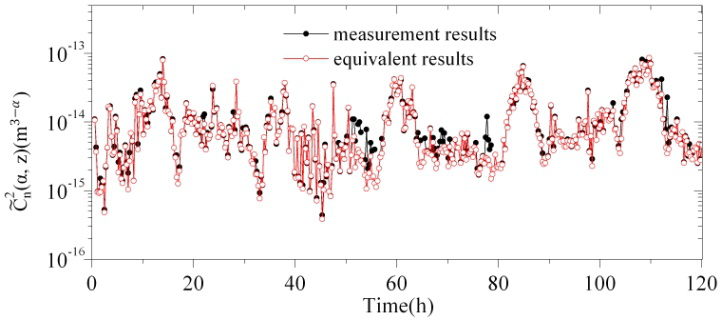Featuring random fluctuations, atmospheric refractive-index caused by turbulence can result in the wave front distortion which disturbs the optical coherence and consequently limits the applications of optical communication, optical remote sensing, optical imaging and so on. Generally used to describe the strength of turbulent fluctuations, refractive-index structure constant features both daily variation and high variation. At present, available measurement data and models of turbulent refractive-index structure constant are based on the Kolmogorov statistical theory.
However, with the development of research on atmospheric turbulence, it is found that atmospheric turbulence does not always conform to the Kolmogorov statistical characteristic. In this case, concept of non-Kolmogorov turbulence was raised as required. In fact, the refractive index structure constant is still used to describe the turbulence fluctuations strength in non-Kolmogorov turbulence. However, instead of “m-2/3” the structure constant has a variational dimension “m3-α” in which α is the spectral power law, causing difficulties in describing the non-Kolmogorov turbulence strength as well as analyzing the light propagation effects in the non-Kolmogorov atmospheric turbulence. In addition, the relation between the Kolmogorov and the non Kolmogorov turbulence remains unsolved in field of optical atmospheric propagation.
lately, ZHU Wenyue and his study team from the Key Laboratory of Atmospheric Composition and Optical Radiation (LACOR) ofAnhui Institute of Optics and Fine Mechanics (AIOFM), Chinese Academy of Sciences raised an equivalent method of non-Kolmogorov turbulent refractive-index structure constant which established the equivalent relationship between the Kolmogorov turbulence refractive-index structure constant and the non- Kolmogorov turbulence refractive-index structure constant. Under the title of Equivalent Refractive-index Structure Constant of Non-Kolmogorov Turbulence, their study was recently publish in the journal of Optics Express (23, 2015 (18), 23004-23012).
Based on the turbulent structure function and the refractive-index fluctuations variance, their study established the relation between the non-Kolmogorov turbulent refractive-index structure constant and the Kolmogorov turbulent refractive-index structure constant and verified the reliability of results by experiments. The equivalent relation shows that the non-Kolmogorov refractive-index structure constant can be expressed as a function of the Kolmogorov refractive-index structure constant, namely the outer scale and the power law. On one hand, this new-established relation can avoid difficulties in using the non-Kolmogorov refractive-index structure constant caused by its variation dimension. On the other hand, the equivalent relation can be used to connect the light propagation properties in Kolmogorov turbulent atmosphere and non-Kolmogorov turbulent atmosphere. Moreover, by combining the out scale models, the spectral power law models and the available Kolmogorov structure constant models, the models of non-Kolmogorov structure constant also can be established based on this new-established equivalent relation.

Comparison of non-Kolmogorov structure constant between measurement results and equivalent results (Image by LI Yujie)
Contact:
ZHU Wenyue , Ph.D Principal investigator
Anhui Institute of Optics and Fine Mechanics, Chinese Academy of Sciences
Hefei, Anhui 230000, China
Tel: 0551-5591004
E-mail: zhuwenyue@aiofm.ac.cn
Drafter: Li Yujie